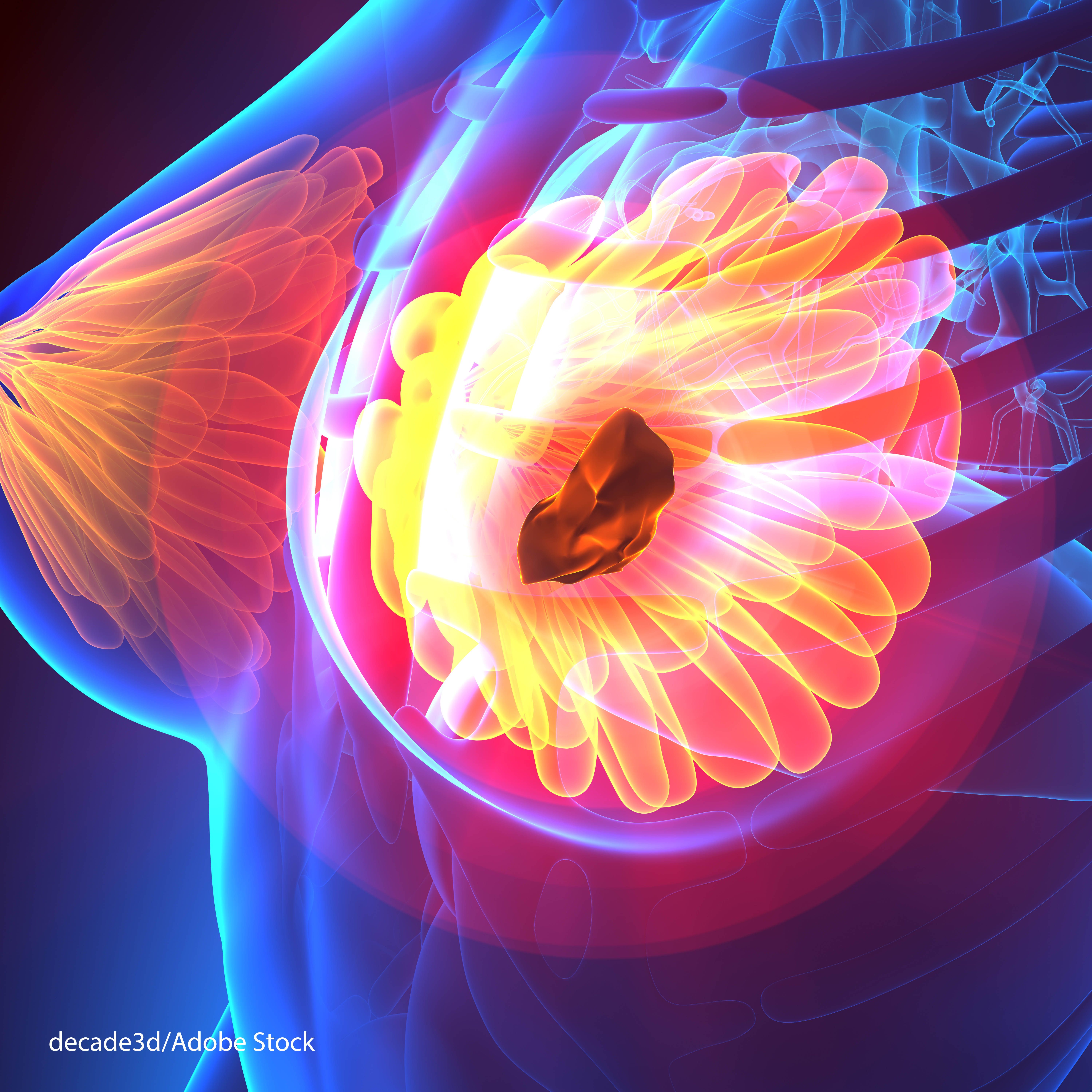Zanidatamab/Evorpacept Combo Yields Promising Activity in HER2+ Breast Cancer
Phase 1b/2 data show antitumor activity with zanidatamab/evorpacept, including among heavily pretreated patients with HER2-low metastatic breast cancer.
Phase 1b/2 data show antitumor activity with zanidatamab/evorpacept, including among heavily pretreated patients with HER2-low metastatic breast cancer.

Combining zanidatamab-hrii (Ziihera) with evorpacept (ALX148) demonstrated promising antitumor activity among patients with HER2-positive metastatic breast cancer, according to findings from a phase 1b/2 study (NCT05027139) presented in a poster session at the 2024 San Antonio Breast Cancer Symposium (SABCS).
In cohort 1, which included patients with HER2-posititve metastatic breast cancer, the confirmed overall response rate (ORR) among all evaluable patients (n = 21) was 33.3% (95% CI, 14.6%-57.0%); all responses were partial responses (PRs). Additionally, the disease control rate (DCR) in this group was 71.4% (95% CI, 47.8%-88.7%), the median duration of response (DOR) was not evaluable (NE; range, 3.6-25.9), and the median progression-free survival (PFS) was 3.6 months (95% CI, 1.8-11.0).
Among patients with HER2-positive disease per central assessment (n = 9) and those who did not have HER2-positive disease via central assessment (n = 12) in cohort 1, respectively, the ORR was 55.6% (95% CI, 21.2%-86.3%) and 16.7% (95% CI, 2.1%-48.4%), which consisted entirely of PRs. Study treatment produced a DCR of 77.8% (95% CI, 40.0%-97.2%) and 66.7% (95% CI, 34.9%-90.1%) in each respective group, and the median PFS was 7.4 months (95% CI, 0.6-NE) and 3.5 months (95% CI, 1.6-14.6). The median DOR was NE among patients with HER2-positive disease per central assessment (range, 5.6-25.9) and without (range, 3.6-15.0).
Of those with HER2-low metastatic breast cancer in cohort 2 (n = 15), the zanidatamab combination yielded an ORR of 20.0% (95% CI, 4.3%-48.1%), which consisted entirely of PRs. Additionally, the DCR was 40.0% (95% CI, 16.3%-67.7%), the median DOR was 5.5 months (range, 3.6-11.0), and the median PFS was 1.9 months (95% CI, 1.6-3.9).
“Zanidatamab plus evorpacept showed promising antitumor activity in patients with heavily pretreated HER2-positive [metastatic breast cancer] including after progression on prior fam-trastuzumab deruxtecan-nxki [T-DXd; Enhertu]…Antitumor activity was also observed in patients with heavily pretreated HER2-low [metastatic breast cancer],” Alberto J. Montero, MD, MBA, CPHQ, and coauthors wrote. “Based on the results presented here, further development of this novel chemotherapy-free regimen is warranted.”
Montero is the clinical director of the Breast Cancer Medical Oncology Program and medical director of the Clinical Trials Unit at University Hospitals Seidman Cancer Center and an associate professor of medicine at Case Western Reserve University School of Medicine in Cleveland, Ohio.
In this open-label, multicenter study, patients with previously treated, inoperable, locally advanced, and/or metastatic HER2-expressing breast cancer or other diseases were assigned to receive zanidatamab at 1200 mg if under 70 kg or at 1600 mg if 70 kg or higher plus evorpacept at 20 mg/kg or 30 mg/kg intravenously every 2 weeks as part of 28-day cycles. In part 2 of the trial, the expansion cohorts included those with HER2-positive metastatic breast cancer in cohort 1, HER2-low metastatic breast cancer in cohort 2, and HER2-positive gastroesophageal adenocarcinoma or other HER2-overexpressing cancers in cohort 3 (n = 8).
The trial’s objectives were safety, tolerability, and recommended doses of zanidatamab plus evorpacept in part 1. In part 2 of the trial, the primary objective was the antitumor activity of zanidatamab and evorpacept across each cohort.
With a median follow-up of 9.6 months (range, 0.6-29.7) and a data cutoff date of August 1, 2024, the median age was 58.0 years (range, 34.0-81.0) in cohort 1, 63.0 years(range, 42.0-74.0) in cohort 2, and 48.5 years (range, 36.0-74.0) in cohort 3. In each respective cohort, most patients were female (100.0% vs 100.0% vs 50.0%) and White (66.7% vs 60.0% vs 75.0%).
In the metastatic setting, patients received a median 6 prior systemic therapies in cohort 1 and 5 in cohort 2. Of note, all patients in cohort 1 received prior treatment with T-DXd. During part 1 of the trial, investigators reported 2 dose-limiting toxicities—grade 3 infusion-related reactions (IRRs)—that resolved after patients terminated treatment.
In cohort 3, treatment produced an ORR of 14.3% (95% CI, 0.4%-57.9%) and a DCR of 42.9% (95% CI, 9.9%-81.6%). Additionally, the median DOR was NE (range, 14.8-14.8), and the median PFS was 1.9 months (95% CI, 1.1-3.8).
Among all evaluable patients in the safety population (n = 52), any-grade treatment-related adverse effects (TRAEs) occurred in 86.5% of patients, with grade 1/2 events highlighted in 73.1%, grade 3 events in 13.5%, and no grade 4/5 events. Serious TRAEs were reported in 5.8% of patients, and 3.8% experienced TRAEs resulting in treatment discontinuation. No patients required dose reductions due to TRAEs.
Treatment-related AEs of special interest included left ventricular dysfunction in 1.9% of patients and IRRs in 23.1%. Common grade 1, 2, and 3 TRAEs included diarrhea (38.5% vs 17.3% vs 5.8%), fatigue (17.3% vs 13.5% vs 1.9%), nausea (21.2% vs 5.8% vs 0%), and IRRs (5.8% vs 13.5% vs 3.8%). Investigators observed no non-infectious pulmonary toxicities or treatment-related deaths.
Reference
Montero AJ, Wisinski KB, Fang B, et al. Zanidatamab in combination with evorpacept in HER2-positive and HER2-low metastatic breast cancer: results from a phase 1b/2 study. Presented at the 2024 San Antonio Breast Cancer Symposium; December 10-14, 2024; San Antonio, TX. Abstract PS8-09.